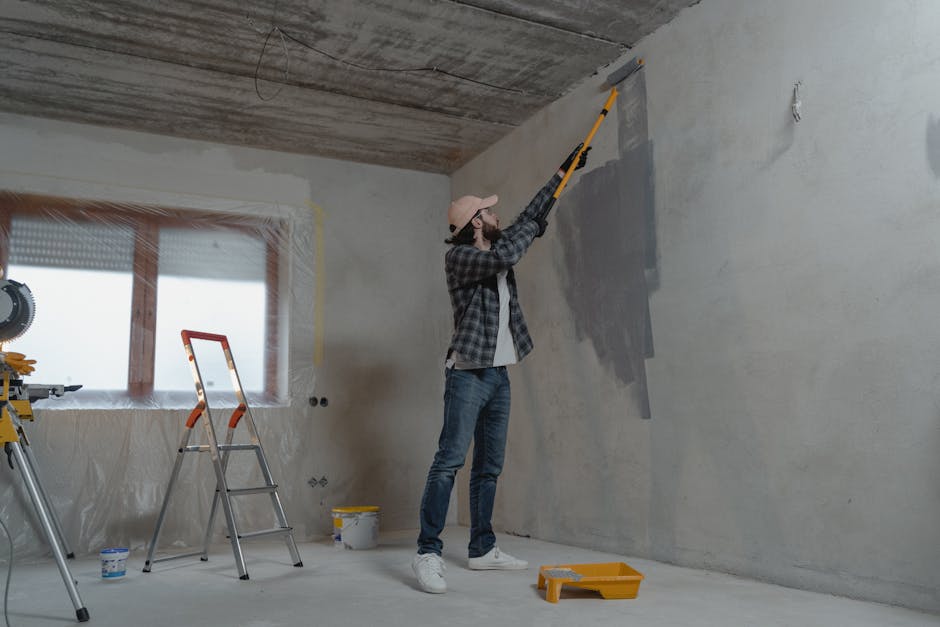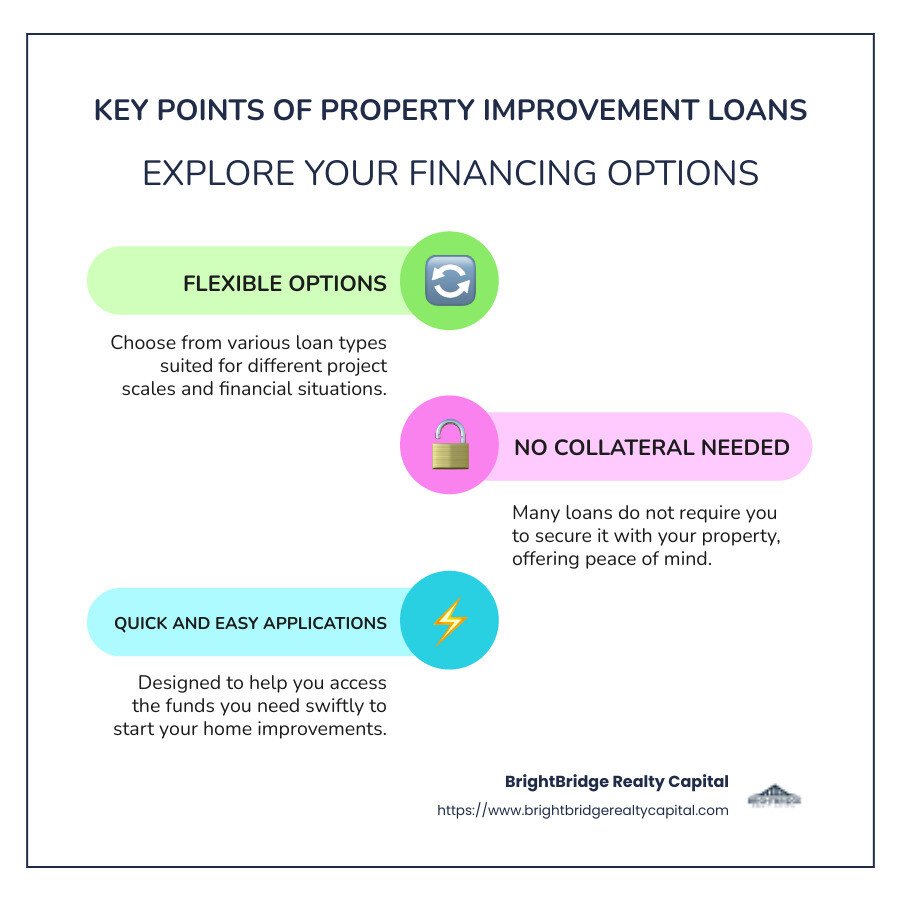Unlocking Home Potential: A How-To on Property Improvement Loans

When it comes to changing a property into your dream home or enhancing its market value, property improvement loans provide the ideal financial gateway. These loans offer flexible financing solutions custom to various home improvement needs, including major renovations or smaller upgrades, like a fancy new kitchen or a sturdy roof.
Key points about property improvement loans:
- Flexible Options: Choose from various loan types to fit your project scale and financial situation.
- No Collateral Needed: Many loans do not require you to secure it with your property.
- Quick and Easy Applications: Designed to help you access the funds you need swiftly.
Whether you're diving into a DIY renovation or hiring a contractor, understanding your financing options is crucial. Property improvement loans can help make your vision a reality without straining your budget.

Understanding Property Improvement Loans
Property improvement loans are designed to help homeowners fund renovations and upgrades, enhancing both comfort and value. These loans come in various forms, each with its own unique benefits and requirements.
Types of Property Improvement Loans
1. Home Improvement Loans:
These are typically unsecured personal loans used for home upgrades. They don't require collateral, meaning you don't have to risk your home to secure the loan. This makes them a flexible option for homeowners seeking quick funding.
2. HUD Title 1 Loans:
Backed by the Federal Housing Administration (FHA), these loans are available for any renovation that makes your home more livable. They offer lower interest rates due to government backing and can be used for a variety of improvements, but not for luxury additions like hot tubs or pools.
3. FHA 203(k) Loans:
These loans allow homeowners to finance up to $35,000 into their mortgage for home repairs or improvements. They're particularly useful for those who may not have significant equity in their home but need to make essential upgrades.
4. Home Equity Loans:
These loans let you borrow against the equity you've built in your home. They provide a lump sum with fixed interest rates, making them a good choice for larger projects. However, they do require using your home as collateral.
Benefits of Property Improvement Loans
Quick Funding:
Many property improvement loans, especially personal loans, offer fast approval and funding, sometimes as quickly as the same business day. This can be crucial for urgent repairs or projects.
No Collateral Required:
Unsecured loans, like many personal loans, don't require you to use your home as collateral. This reduces the risk to your property if you're unable to repay the loan.
Fixed Interest Rates:
Loans like home equity and certain personal loans offer fixed interest rates, providing predictable monthly payments. This can help with budgeting and financial planning.
Visual Aid

By exploring these options, you can find a loan that aligns with your needs and financial situation, ensuring that your home improvement project is both achievable and affordable.
How to Apply for Property Improvement Loans
Applying for a property improvement loan might seem daunting, but breaking it down into steps can simplify the process. Here's a straightforward guide to help you secure the funding you need for your home renovation projects.
Steps to Secure a Loan
Check Your Credit Score:Before applying, know your credit score. This number plays a big role in your loan terms and interest rates. Most lenders prefer a score of at least 560, but higher scores can lead to better terms.
Research Loan Options:Compare different loans to find the best fit for your needs. Look at interest rates, repayment terms, and any fees. Personal loans, home equity loans, and government-backed options like HUD Title 1 loans all have different benefits.
Gather Required Documents:Prepare your legal name, address, birthdate, Social Security number, and state-issued ID. Some lenders might also ask for bank statements or proof of income.
Apply Online:Many lenders offer online applications for convenience. Fill out the application carefully, ensuring all information is accurate to avoid delays.
Get Same-Day Approval:Some lenders offer quick approvals, sometimes within the same day. This is particularly true for personal loans, making them a great option for urgent projects.
Key Considerations Before Applying
Loan Terms:Understand the loan duration and how it affects your monthly payments. Longer terms mean lower payments but more interest over time.
Interest Rates:Fixed rates provide stability, while variable rates might offer lower initial costs but can increase over time. Choose based on your financial comfort and market predictions.
Repayment Options:Evaluate whether you can afford the monthly payments. Some loans offer flexible repayment terms that can be adjusted based on your financial situation.
Eligibility Requirements:Each loan type has different criteria. For example, FHA 203(k) loans require the home to meet certain standards, while personal loans focus more on credit scores and income levels.
By understanding these steps and considerations, you can confidently steer the loan application process, ensuring you secure the best possible terms for your property improvement project.
Government Assistance Programs
Government assistance programs can make home repairs and renovations more affordable. These programs are designed to help specific audiences, such as low-income families, veterans, and rural residents, access funds for necessary home improvements. Let's explore two key programs: the HUD Title 1 Property Improvement Loan Program and the 203(k) Rehabilitation Mortgage Insurance Program.
HUD Title 1 Property Improvement Loan Program
The HUD Title 1 Property Improvement Loan Program offers loans that can be used for a wide range of home repairs and improvements. This program is particularly beneficial for homeowners who need to make their homes safer or more livable but lack the upfront cash to do so.
Eligibility Criteria:
- Income Level: Your income should align with the program's requirements, which vary by location.
- Property Type: The loan is available for single-family homes, multifamily properties, and non-residential structures.
- Location: Availability might depend on your home's location, as some areas have more funding opportunities.
Loan Amounts and Repayment Terms:
- Loan Limits: The maximum loan amount for a single-family home is $25,000. For multifamily properties, it can go up to $60,000.
- Repayment Terms: Loans can be repaid over a period of up to 20 years, depending on the amount borrowed and the type of property.
This program is ideal for those who need to make essential repairs or improvements, such as fixing a roof, upgrading plumbing, or enhancing energy efficiency.
203(k) Rehabilitation Mortgage Insurance Program
The 203(k) Rehabilitation Mortgage Insurance Program is another government-backed loan option that allows homeowners to finance both the purchase and renovation of a home through a single mortgage. This program is especially useful for those buying older homes that need significant repairs.
Eligibility Criteria:
- Primary Residence: The home must be your primary residence.
- Project Scope: The renovations should align with the program's guidelines and improve the property’s safety, functionality, or energy efficiency.
Financing Options and Home Repairs:
- Limited 203(k): This option is for minor repairs and is capped at $35,000. It’s perfect for projects like updating a kitchen or bathroom.
- Standard 203(k): This option covers extensive work, including structural changes, with no cap on repair costs, as long as it falls within the FHA mortgage limit for the area.
Financing Options:
- Combined Loan: The program combines the purchase price and renovation costs into a single mortgage, simplifying the process for buyers.
- Escrow Account: Funds for renovations are held in an escrow account and disbursed as work is completed.
These programs offer a path to home ownership and improvement for those who might not otherwise afford it. By understanding the eligibility criteria and benefits, you can determine if these government-backed options are right for your home improvement needs.
Frequently Asked Questions about Property Improvement Loans
What is a property improvement loan?
A property improvement loan is a type of financing designed to help homeowners fund renovations and repairs. These loans can be used for projects big and small, from adding a new room to updating outdated systems like HVAC or plumbing. Unlike a single loan type, property improvement loans encompass various financing options, allowing homeowners to choose based on their needs and financial situation.
How do property improvement loans work?
Property improvement loans work by providing homeowners with the funds needed to make upgrades or repairs. The way these loans function can vary:
Secured Loans: These are backed by collateral, typically your home. They often have lower interest rates because they're less risky for lenders. Examples include home equity loans and cash-out refinances.
Unsecured Loans: These don't require collateral, making them quicker to process. However, they might come with higher interest rates. Personal loans fall into this category and are popular for smaller projects.
Government Loans: Programs like the HUD Title 1 and 203(k) loans offer government-backed options, often with favorable terms for eligible homeowners.
Each loan type has its own application process, interest rates, and repayment terms, so it's crucial to understand these elements before proceeding.
What is the difference between a personal loan and a home equity loan?
The primary difference between a personal loan and a home equity loan lies in collateral and usage:
Personal Loan: This is an unsecured loan, meaning you don't need to put up your home as collateral. It's ideal for smaller projects or when you need funds quickly. However, the interest rates might be higher, and the loan amounts smaller.
Home Equity Loan: This is a secured loan, using your home equity as collateral. It typically offers lower interest rates and higher loan amounts, making it suitable for larger renovations. The downside is the risk of losing your home if you default.
Both options have pros and cons, so consider your financial situation and project scope when choosing the right loan for you.
Conclusion
In home improvement, securing the right financing can be a game-changer. That's where BrightBridge Realty Capital steps in, offering customized financing solutions custom to meet your specific needs. Whether you're looking to renovate your kitchen, add an extra room, or make energy-efficient upgrades, we have the expertise and resources to help you open up your home's potential.
What sets us apart is our commitment to quick closings. We understand that time is of the essence, especially when dealing with home improvement projects. Our streamlined process ensures that you can secure funding often within a week, allowing you to start your project without unnecessary delays. This speed is made possible because we are a direct lender, eliminating the middleman and providing you with competitive rates and a seamless experience.
Our nationwide presence means that no matter where your property is located, we're here to help. We provide a variety of property improvement loans, including options for those with less-than-perfect credit. Our goal is to make the process as smooth and stress-free as possible, so you can focus on what matters most—changing your house into the home of your dreams.
Ready to get started? Explore our loan options and see how BrightBridge Realty Capital can help you achieve your home improvement goals.


